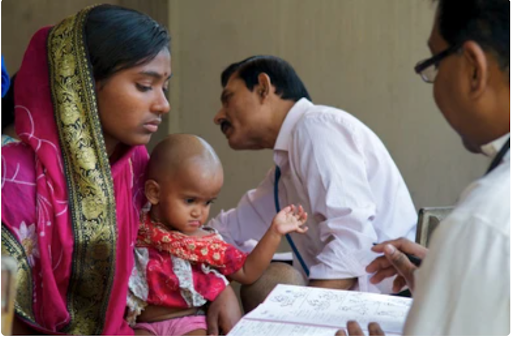Based on this definition, only 38% of households in India are digitally literate. In urban areas, computer literacy is relatively higher at 61% whereas in rural India the percentage has barely touched 25%.
Client Brief
A Seattle based non-profit organisation looking to expand its presence to India, after having established a footprint in 180 other countries tied up with Sattva to help them articulate their approach to entering the country, develop a deeper understanding of the Indian context, and build a network of partnerships with local players who would support in deploying their solutions.
The organisation’s goal in India is to provide disadvantaged students in the K-12 segment with access to its Computer Science Education (CSEd) and effectively engage with the CSEd ecosystem to build awareness of the role that CSEd can play in building computational skills, logical thinking and creativity. Towards this, the organisation hopes to work with other CSEd solution providers, students, educators, and education-focused nonprofits that have a deep presence on the ground, among others, while running awareness-building campaigns that can build a movement for CSEd across the country.
Sattva’s Approach
Sattva’s Retained Advisory team has been working with this nonprofit since April 2021 on its market entry and partnerships strategy. Sattva’s work on the engagement is anchored around four key aspects:
- Market entry strategy and execution: Articulating the approach through which the organisation would enter and establish its presence in the CSEd ecosystem in India
- Partnerships strategy, outreach, and management: Developing an approach to identifying and entering partnerships with local players to deploy the solutions at scale
- Programme management: Establishing a predictable, agile and effective working approach with the organisation, its funders, and partners across all levels and tracks to ensure seamless execution of the market entry and partnerships strategy
- Funder engagement: Support in identifying prospective funders and securing the requisite funding required to aid the organisation’s work and expansion in India
People and Expertise
NonProfit Advisory team members, led by our Managing Director have been anchoring the project engagement from design to execution across all tracks.
The project core team, along with the in-house Tech and Data team, is exploring the feasibility of handling the localisation of the curriculum as well as of the platform (i.e the website https://code.org/ which houses the CS curriculum and learning platform). This includes translating content into Indian regional languages, skinning the organisation’s platform (currently catering to an English speaking, American audience), setting up an offline interface and creating a mobile-based or mobile view optimised application.
Demographic profile of beneficiaries/Sample details
- Geography covered: 21+ states*
- Sample Size/Scale: over 120k students
- Relevant demographic markers: The client has a focus on catering to underserved and disadvantaged communities such as girls, tribal communities, people in remote regions etc. All of the 15 implementation partners work primarily in government schools in both urban and semi-urban regions and cater to students belonging to the lower income strata, most of whom are first-generation learners. Some of the partners also have a focused presence in rural areas and cater specifically to tribal communities and specially-abled children.
- Partners: Sattva has enabled the client to enter into 15 partnerships with local, non-profit organisations that run programmes in education and have volunteered to implement the client’s CSEd solutions with students and educators on the ground.
Methodology
- Developed an outside-in perspective on the market:
- Conducted primary and secondary research of the CSEd ecosystem to map opportunities, challenges, and barriers that disadvantaged students face when accessing CSEd.
- Studied various states across India to develop a ‘state selection framework’ that helped identify suitable geographies for the effective rollout of the organisation’s CSEd curriculum
- Conducted early problem solving to map various market entry approaches:
- Developed a framework to articulate archetypes of potential partners that the organisation can work with to deploy its solutions
- Defined various ways to enter the market and deploy solutions at scale including a top down (large-scale campaign to launch the organisation in the country to generate demand among communities and orchestrating an alliance of CSEd players) and a bottoms-up approach (staged expansion plan via local implementing partners)
- Defined the market entry strategy via the chosen partnerships-based approach:
- Structured a partnerships outreach and engagement approach to help the organisation work with the right partners
- Developed a comprehensive partner identification and prioritisation framework that used a weighted scoring approach to identify and conduct outreach to shortlisted organisations in a phased manner
- Anchored and fostered relationships with all partner organisations and acted as the first point of contact by being the face of the organisation’s work in India
- Provided end-to-end programme management support
- Continually assessed product-market fit and invested effort towards strengthening it to effectively cater to the needs of the targeted customer
- Designed and owned project management tools and processes to streamline the client’s internal work and stakeholder engagement systems including gathering feedback and risks from the ground
- Created relevant resources, tools, and material required to enable the implementation of the client’s CSEd solutions
- Established a predictable, agile and effective working approach across stakeholder types, levels, and work tracks
Key Learnings
- Ecosystem
- Policy focus and government push on fostering CSEd in the country are helping drive efforts towards this direction. Some of the implementation partners are working closely with the government bodies in setting the curriculum, expanding the reach of CSEd across the district/state etc.
- While demand for CSEd is no longer a challenge, low resource settings inhibit growth and limit opportunities to scale. Key barriers to access and adoption continue to be lack of digital infrastructure and literacy, teacher capacity and inadequate general infrastructure such as electricity, consistent mobile network coverage, wifi, etc.
- Parents, educators, and school administrators are all sold on the idea of CSEd and its importance, but India is still a while away from seeing CS as a foundational subject. Focus is always on how what the student is studying leads to tangible outcomes, and therefore the linkage between CSEd and employability needs to be continually reinforced as this connection is not apparent.
- Market Entry
- Educating key decision makers of an organisation entering new geography on the nuanced context and on-ground challenges is essential to ensure relevant efforts
- Getting direct, first person feedback from those who interact with the target customers on the product-market fit helps redefine the product to suit the needs of the target demography.
- Continually assessing the product market fit to determine what can be improved in the product so as to keep refining the profile of an organisation’s targeted demography ensures quick adoption.
- Developing a win-win approach to engaging with other players in the space vs a transactional one is the key to strengthening the ecosystem as a whole.
- Fostering partnerships
- Taking a demand-based approach to partnerships vs. a push-based strategy is more successful since only those who truly align with the vision will seek to partner and work.
- Providing adequate clarity on the value proposition to the ecosystem and to local partners helps garner the needed traction.
- Investing the time and effort needed to build trust-based relationships and being cognizant of how you can aid your partners and not burden them further with unnecessary reporting etc. is imperative for a synchronised working
Impact of project/Sattva’s assistance
- Through this engagement, the client entered into a partnership with over 15 organisations spread across 21 states. These organisations are able to deploy the solutions on ground in the most effective and student friendly manner.
- Sattva has played a successful role in building an agile approach to project management and forming a relationship of trust with the partners.
- Through our efforts at designing, implementing and managing the stakeholder relationship, Sattva has been able to gain and share several insights on the Indian ecosystem useful for curriculum implementation and achieving the product market fit.
- Sattva has also collectively identified with the client the most attractive curriculum/activity, intervention type, geography, etc. for the Indian geography, in order to drive significant efforts in that direction
- The client was made aware of the potential to impact at scale in India and also of the existing capabilities and co-existing gaps.
- The client is also abreast of the challenges in deployment and execution and is able to work backwards with us in order to plug in those gaps and achieve the right product market fit.
Highlights
We had a successful one year of engagement with the client and further extended it for another term to drive significant efforts towards seeing results on the ground




